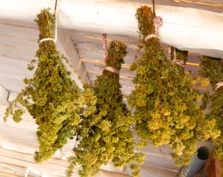Origanum vulgare ssp. hirtum
Greek oregano Ελληνική ρίγανη

Lamiaceae - mint family Dicot
Origanum vulgare ssp. hirtum
Greek oregano Ελληνική ρίγανη

Lamiaceae - mint family Dicot
Grown by the goddess Aphrodite on Mount Olympos, oregano, was given to man as a symbol of joy.
The tiny, white flowers are arranged in rounded terminal clusters on branched stems, which are square in cross section. The young leaves are opposite, ovate and bright green; the whole plant is covered in glandular hairs.
The plants contain important aromatic oils, which, as well as being important for flavouring, have anti-bacterial and anti-fungal properties; it has been used medicinally since ancient times. A study carried out in 1992 on concentrations of essential oils in O. vulgare ssp. hirtum collected in different parts of Greece, found that samples gathered on Skopelos contained 25 compounds, whereas those from Evia, only 10. The study concluded that plants at lower altitude and in hotter environment contained higher concentrations of essential oils. The oregano of Skopelos can certainly be regarded as very special.




Greek Oregano - Ελληνική ρίγανη
Growing wild on Skopelos, oregano (ρίγανη), fills fields, olive groves and forest clearings with its spicy aroma. It is the favourite herb of the Skopelitians, gathered in June, while it is in flower. The herbs are rinsed in cold, clear water, tied into tight bunches and hung up to dry, away from direct sunlight. The flower heads are then stripped off the stems and stored in jars, for use throughout the year. It is an important ingredient in many traditional recipes and no Greek salad is complete without a drizzle of olive oil and a generous sprinkle of rigani, oregano.
1. Geographic variation of Greek Oregano (Origanum vulgare ssp. hirtum) essential oils. D. Vokou, S. Kokkini & J-M Bessiere. Biochemical Systematics and Ecology. 1993.


